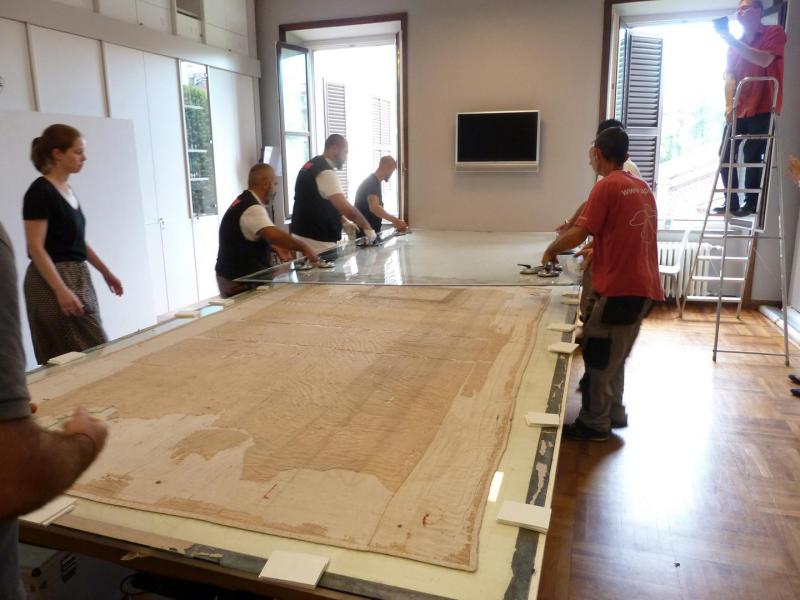DepthReading
Long-awaited rescue for valuable silk tunic
UNTIL NOW, A HEAVY GLASS PANE WEIGHING APPROXIMATELY 80 KILOS HAS PREVENTED A VALUABLE, CENTURIES-OLD SILK TUNIC ATTRIBUTED TO SAINT AMBROSE FROM BEING RESTORED IN MILAN.
With a team of restorers and art transporters, an archeologist at the University of Bonn has now managed to free the work of art, the tunic, from its heavy load, preserve the fabric and thus retain it for posterity.
Already in the early Christian church, relics were widespread. The religiously revered legacies of the saints also include, for instance, textiles. Valuable silk garments in Milan are thus attributed to Saint Ambrose. The patron saint of the city lived in the fourth century, and his remains rest there in the Basilica of Sant’Ambrogio, which bears his name. As bishop of the imperial residence of Milan, Ambrose pushed for the veneration of relics, and the Ambrosian chants, for instance, also date back to his time.
“The silk garments that are venerated as relics of the saint also include an exquisitely beautiful tunic,” says Prof. Sabine Schrenk from the department of Christian Archeology at the University of Bonn. The ravages of time have taken their toll on the valuable textile, yet it was not possible to perform new preservation work because the silk tunic has been stored in Milan for many years under a heavy glass pane weighing around 80 kilos. “The glass was intended to protect the relic,” reports Schrenk. “However, the silk textile created waves underneath, and the great weight of the glass pane thus damaged the centuries-old fibers.”
Experts have extensive experience with valuable silk textiles
Preserving the garment was a major challenge: how can the glass be removed from the silk cloth without it breaking or it tearing the fibers that have adhered to it? As Sabine Schrenk and the Colgne-based textile restorer Ulrike Reichert had already successfully preserved numerous silk fabrics in Sant’Ambrogio both of the experts have long been considering how such a tricky venture could succeed.
Schrenk and Reichert devised a plan with those in charge at Sant’Ambrogio, Abate Erminio de Scalzi and Monsignore Biaggio Pizzi, as well as with the curators of monuments from the diocese and city, Dr. Carlo Capponi and Dr. Antonella Ranaldi. The art transporting company APICE from Milan played an important role in this: well accustomed to shipping heavy paintings and sculptures, the experts led by Fabiano Panzironi took on the heavy task of transporting and lifting the glass pane installation.
The silk tunic measuring an impressive approx. 170 x 280 centimeters was stored in a drawer cabinet in the gallery of Sant’Ambrogio. However, this room was unsuitable for the preservation work. The transporters thus packed the glass panes with the valuable cargo between two large wooden boards, and the huge artwork was then carried vertically along the narrowest, winding corridors into the basilica’s archive, which was transformed into a workshop for a month. “This transportation was highly risky,” reports the restorer Ulrike Reichert. In some places, the art transporters had to proceed millimeter by millimeter to ensure the transit was ultimately successful.
A sandwich made from wood, glass and silk tunic
Once they arrived in the workshop, the six art transporters heaved the glass, silk tunic and wood sandwich onto a large table. The most dangerous moment of the preservation was now imminent. While the art transporters lifted the glass pane very slightly using suction handles, Ulrike Reichert used a flat stick to very carefully separate adhering parts of the silk tunic from the glass pane square centimeter by square centimeter. “This work took a long time – for the helpers, it was a feat of strength to keep the heavy pane in the air the whole time,” says Schrenk.
Then came the key moment: will the upper glass pane break when lifted and tear the tunic? Very carefully, the specialists lift the heavy pane centimeter by centimeter using the suction handles. The silk fibers remain intact! The carriers quickly lift the glass pane to one side and place it down on the table. The valuable fabric is now accessible for preservation. The fine silk fibers are carefully freed from dust and the valuable tunic is then protected against environmental influences with a lightweight acrylic glass. “The success shows that it was right to take the gamble,” says Schrenk. “The great team mastered this challenge together.” The project was sponsored by the Gielen-Leyendecker Foundation.
Category: English
DepthReading
Key words:

